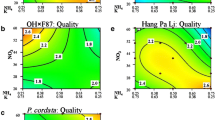Abstract
The objective of this study was to improve shoot regeneration from grapefruit. Because many commercially grown citrus types are apomictic, important in vitro applications such as Agrobacterium-mediated transformation commonly use epicotyl explants from in vitro seedlings; thus, adequate adventitious shoot production is an important prerequisite for efficient use of these applications. Eight plant growth regulators were studied—six cytokinins (6-benzylaminopurine, kinetin, zeatin trans-isomer, 6-[γ,γ-dimethylallylamino] purine, zeatin riboside trans-isomer and meta-topolin) and two auxins (α-naphthalene acetic acid and indole-3-acetic acid). An iterative design strategy was followed that included mixture and mixture-amount experimental designs suitable for resolving proportional and concentration effects; in vitro effects of cytokinins and auxins are affected by both proportion and concentration. One-centimeter-long explants were excised from the epicotyl of etiolated, in vitro-grown seedlings. Explants were placed onto experimental formulations and cultured in growth cabinets at 27°C over 6 wk, which included 2 wk in the dark followed by 4 wk in the light. The results indicated that (1) 6-benzylaminopurine or zeatin riboside were the most effective cytokinins for inducing shoot regeneration in citrus; (2) zeatin riboside singly or in combination with indole-3-acetic acid resulted in the highest quality, the greatest number of explants with buds/shoots, and the greatest shoot number; and (3) 6-benzylaminopurine and indole-3-acetic acid improved shoot regeneration vs. 6-benzylaminopurine at a considerably lesser cost than zeatin riboside and indole-3-acetic acid.






Similar content being viewed by others
References
Anderson, M.J.; Whitcomb, P.J. RSM simplified: optimizing processes using response surface methods for design of experiments. Productivity Press, New York, pp 120–121, 226–228; 2005
Belsley D. A.; Kuh E.; Welsch R. E. Regression diagnostics: identifying influential data and sources of collinearity. Wiley, Hoboken; 1980.
Box G. E. P.; Cox D. R. An analysis of transformations. J Royal Stat Soc Series B 26: 211; 1964.
Burger D. W.; Hackett W. P. Gradients of adventitious bud formation on excised epicotyl and root sections of citrus. Plant Science 43: 229–232; 1986.
Cook R. D.; Weisberg S. Residuals and influence in regression. Chapman and Hall, New York; 1982.
Cornell J. A. Experiments with mixtures: designs, models and the analysis of mixture data, 3rd ed. Wiley, New York; 2002.
Costa M. G. C.; Alves V. S.; Lani E. R. G.; Mosquima P. R.; Carvalho C. R.; Otoni W. C. Morphogenic gradients of adventitious bud and shoot regeneration in epicotyl explants of citrus. Scientia Horticulturae 100: 63–74; 2004.
Cox D. R. A note on polynomial response functions for mixtures. Biometrika 58: 155–159; 1971.
Derringer G. C.; Suich R. Simultaneous optimization of several variables. J. Qual. Tech 12: 214–219; 1980.
Duran-Vila N.; Ortega V.; Navarro L. Morphogenesis and tissue cultures of three citrus species. Plant Cell Tissue and Organ Culture 16: 123–133; 1989.
Evens, T.J.; Niedz, R.P. Are Hofmeister series relevant to modern ion-specific effects research? Scholarly Research Exchange, vol. 2008, Article ID 818461; 2008. doi:10.3814/2008/818461.
Evens T. J.; Niedz R. P. Optimal N:P ratios of growth media: quantification of nutrient-replete growth rates in five ion hyperspace for Chlorella vulgaris (Chlorophyceae) and Peridinium cinctum (Dinophyceae). Eur J Phycol 45: 247–257; 2010.
Grinblat U. Differentiation of citrus stem in vitro. Journal of the American Society for Horticultural Science 97: 599–603; 1972.
Kobayashi A. K.; Bespalhok J. C.; Pereira L. F. P.; Vieira L. G. E. Plant regeneration of sweet orange (Citrus sinensis) from thin sections of mature stem segments. Plant Cell Tissue and Organ Culture 74: 99–102; 2003.
Murashige T.; Tucker D. P. H. Growth factor requirements of citrus tissue culture. Proc 1st Int Citrus Symp 3: 1155–1161; 1962.
Myers R. H. Classical and modern regression with applications. 2nd ed. PWS-KENT Publishing, Boston; 1990.
Myers R. H.; Montgomery D. C. Response surface methodology: process and product optimization using designed experiments. 2nd ed. Wiley, New York; 2002.
Niedz R. P.; Evens T. J. Regulating plant tissue growth by mineral nutrition. In Vitro Cell & Dev Biol Plant 43: 370–381; 2007.
Niedz R. P.; Evens T. J. The effects of nitrogen and potassium nutrition on the growth of nonembryogenic and embryogenic tissue of sweet orange (Citrus sinensis (L.) Osbeck). BMC Plant Biology 8: 126; 2008. doi:10.1186/1471-2229-8-126.
Niedz R. P.; Hyndman S. E.; Evens T. J. Using a gestalt to measure the quality of in vitro responses. Scientia Horticulturae 112: 349–359; 2007.
Paudyal K. P.; Haq N. In vitro propagation of pummelo (Citrus grandis L. Osbeck). In Vitro Cellular & Developmental Biology-Plant 36: 511–516; 2000.
Perez-Molphe-Balch E.; Ochoa-Alejo N. In vitro plant regeneration of Mexican lime and mandarin by direct organogenesis. HortScience 32: 931–934; 1997.
Skoog F.; Miller C. O. Chemical regulation of growth and organ formation in plant tissues cultured in vitro. Symp. Soc. Exper. Biol. 11: 118–131; 1957.
Smith, W.F. Experimental design for formulation. ASA-SIAM Series on Statistics and Applied Probability, SIAM, Alexandria, VA, USA; 2005.
Weisberg S. Applied linear regression. 2nd ed. Wiley, New York; 1985.
Zou X.; Li D.; Luo X.; Luo K.; Pei Y. An improved procedure for Agrobacterium-mediated transformation of trifoliate orange (Poncirus trifoliata L. Raf.) via indirect organogenesis. In Vitro Cellular & Developmental Biology—Plant 44: 169–177; 2008.
Acknowledgment
We thank Mr. Eldridge Wynn for his careful preparation of the media formulations, growth of the plant cultures, and setup and collection of the data for this study.
Author information
Authors and Affiliations
Corresponding author
Additional information
Editor: J. Finer
Rights and permissions
About this article
Cite this article
Niedz, R.P., Evens, T.J. Mixture screening and mixture-amount designs to determine plant growth regulator effects on shoot regeneration from grapefruit (Citrus paradisi macf.) epicotyls. In Vitro Cell.Dev.Biol.-Plant 47, 682–694 (2011). https://doi.org/10.1007/s11627-011-9381-4
Received:
Accepted:
Published:
Issue Date:
DOI: https://doi.org/10.1007/s11627-011-9381-4




